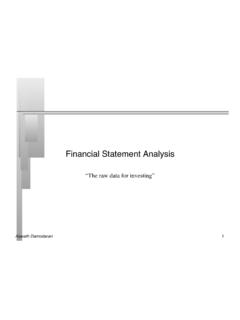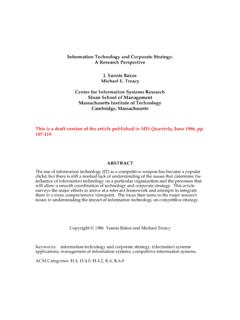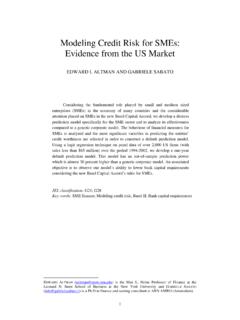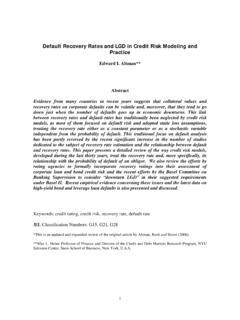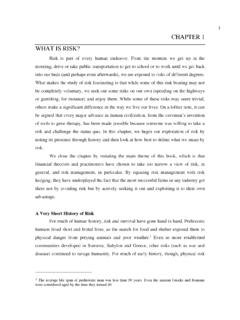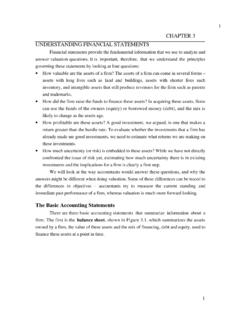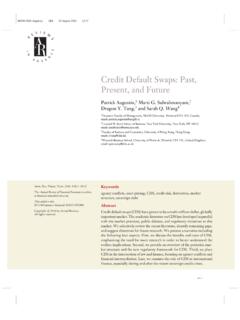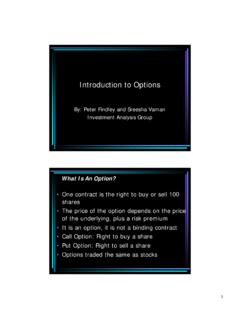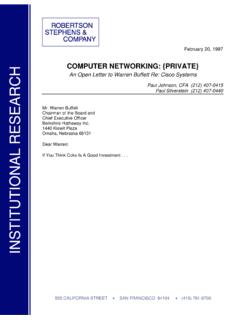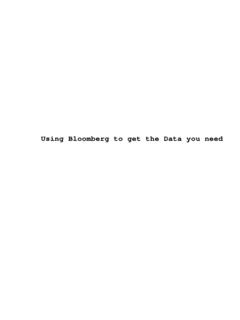Transcription of The Capital Asset Pricing Model (CAPM) - New York University
1 Foundations of Finance: The Capital Asset Pricing Model (CAPM) Prof. Alex Shapiro1 Lecture Notes 9 The Capital Asset Pricing Model (CAPM)I. Readings and Suggested Practice ProblemsII. Introduction: from Assumptions to ImplicationsIII. The Market PortfolioIV. Assumptions Underlying the CAPMV. Portfolio Choice in the CAPM WorldVI. The Risk-Return Tradeoff for Individual StocksVII. The CML and SMLVIII. Overpricing / Underpricing and the of CAPM in Corporate ReadingsBuzz Words: Equilibrium Process, Supply Equals Demand, MarketPrice of Risk, Cross-Section of Expected Returns,Risk Adjusted Expected Returns, Net Present Valueand Cost of Equity of Finance: The Capital Asset Pricing Model (CAPM) 2I.
2 Readings and Suggested Practice ProblemsBKM, Chapter 9, Sections Problems, Chapter 9: 2, 4, 5, 13, 14, 15 Web: Visit , select a fund ( , Vanguard500 Index VFINX), click on Risk Measures, and in the ModernPortfolio Theory Statistics section, view the Introduction: from Assumptions to ImplicationsA. Economic Equilibrium1. Equilibrium analysis (unlike index models)Assume economic behavior of , draw conclusions about overall market prices,quantities, The CAPM is based on equilibrium analysisProblems: There are many dubious assumptions. The main implication of the CAPM concernsexpected returns, which can t be observed of Finance: The Capital Asset Pricing Model (CAPM) 3B.
3 Implications of the CAPM: A PreviewIf everyone believes this then (as we will see next):1. There is a central role for the market portfolio:a. This simplifies portfolio Provides a rationale for a market-indexing There is explicit risk-return trade-off for individual stocks:The Model specifies expected returns for use in capitalbudgeting, valuation, and premium on an individual security is a function of itssystematic risk, measured by the covariance with the can use the Model to evaluate given estimates of expectedreturns relative to riskb. Can obtain estimates of expected returns throughestimates of risk. (This is more precise statistically thanobtaining direct estimates of expected returns based onaverages of past returns)Foundations of Finance: The Capital Asset Pricing Model (CAPM) 4 III.
4 The Market PortfolioThe market portfolio, M, as any other portfolio, is describedby portfolio weights:w1,M, .., wn, specific attribute of the market portfolio is that theweight on a stock is the fraction of that stock s market valuerelative to the total market value of all stocks:Stock s market value:vi = ni piwherepiprice per share of company i s stock,ninumber of shares outstanding,vithe market value of i s :IBM has nIBM=1730 Million shares outstanding. As of 10/6/03, the price was pIBM=$ per share. So, IBM s market value is vIBM=$ BillionThe total market value of all stocks: V = v1+v2+..+vnThe weight of stock i in the market portfoliowi,M = vi / the weight of IBM is: wIBM = we put $100,000 in the market portfolio, $1,500 should be investedin of Finance: The Capital Asset Pricing Model (CAPM) 5IV.
5 Assumptions Underlying the CAPM There are many investors. They behave competitively (pricetakers). All investors are looking ahead over the same (one period)planning horizon. All investors have equal access to all securities. No taxes. No commissions. Each investor cares only about ErC and C. All investors have the same beliefs about the investmentopportunities: rf, Er1,..,Ern, all i, and all correlations ( homogeneous beliefs ) for the n risky assets. Investors can borrow and lend at the one riskfree rate. Investors can short any Asset , and hold any fraction of an of Finance: The Capital Asset Pricing Model (CAPM) 6V.
6 Portfolio Choice in the CAPM WorldA. The investor s problem is to choose the best portfolio solution: Choose P=T B. If T is the same for everybody (all investors agree on whatare the tangent weights), then T is the Market portfolio (M).That is, each Asset s weight in the tangent portfolio, wi,T, issimply its weight in the market portfolio: wi,T = wi,MV = total market value of all stocks = total funds invested in the tangent portfoliovi = market value of i's equity = total funds invested in firm i= wi,T (total funds invested in the tangent portfolio)= wi,T Vrf CAL (Riskyassets)Foundations of Finance.
7 The Capital Asset Pricing Model (CAPM) 7 Therefore,wi,T = VVwTi , = Vvi = wi,MExampleSuppose based on the Mean-Variance analysis, IBM s weightin the tangent portfolio is wIBM,T = 1% (all investors agree onthat), and all investors combined have $12 trillion to invest(so V= $12 trillion).Then, IBM s market value isvIBM = wIBM,T V = 1% 12 trillion = $120 billionand IBM s market weight iswIBM,M = vIBM/V = $120 billion/12 trillion = 1% = wIBM,TSo everyone holds some combination of the value weightedmarket portfolio M and the riskless Capital Market Line (CML)The CAL, which is obtained by combining the marketportfolio and the riskless Asset is known as the CapitalMarket Line (CML):ErrErrCfMfMC=+ Foundations of Finance: The Capital Asset Pricing Model (CAPM) 8Er D.
8 IndexingThe portfolio strategy of matching your portfolio (of risky assets)to a popular Indexing is a passive strategy. (No security analysis; no market timing. )2. Some stock indices ( , the S&P 500 index) use marketvalue If the total value of the stocks in the index is close to thevalue of all stocks, then it may approximate the marketportfolio. 4. Conclusion: the investor can approximate the marketportfolio by matching a market ( Capital Market Line)MFoundations of Finance: The Capital Asset Pricing Model (CAPM) 9VI. The Risk-Return Tradeoff for Individual StocksA. The CML specifies the expected return, ErC, for a given levelof risk ( C) in our combined possible combined portfolios lie on the CML, and all areMean-Variance efficient an individual stock lie on the CML?
9 Er ErIBM IBM rf CMLM IBMF oundations of Finance: The Capital Asset Pricing Model (CAPM) 10B. How should we measure the risk of an Asset (IBM)?As an investor, I care only about C (the risk in my combinedportfolio). The risk in C derives entirely from the risk in themarket portfolio M: C = y MWhat does IBM contribute to M?We can answer that using a thought experiment , where weconsider the covariance of the Asset with the market, iM, orequivalently its beta, because iM = iM/ 2M.[ iM is often written simply as i (note: M = 1), and it measureshow much an Asset s return is driven by the market return.]
10 ]So now consider the following marginal portfolioformation scenario:An investor holds the market portfolio. A new stock is issued. The investor is considering adding it to his of Finance: The Capital Asset Pricing Model (CAPM) 11If the stock has a high positive :- It will have large price swings driven by the market- It will increase the risk of the investor s portfolio(in fact, will make the entire market more risky ..)- The investor will demand a high Er in the stock has a negative :- It moves against the It will decrease the risk of the market portfolio- The investor will accept a lower Er (in exchange forthe risk reduction, and Er can be negative).
